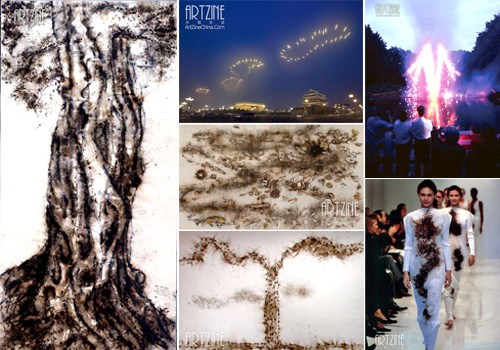Cai went to Japan in 1986, where he began to explore the properties of gunpowder in his drawings. The inquiry eventually led to his experimentation with explosives on a massive scale and to the development of his signature explosion events.
According to Cai, he is interested in using gunpowder because it has a "strong cultural significance" and can be related to his hometown, which is famous for the manufacture of firecrackers.
"Later I learned that gunpowder, which was invented in China, has a strong cultural meaning. It was originally related to people's desire for longevity. As a symbol of violence, it has also played an important role in the destruction and reconstruction of history. That's where my inspiration came from," said Cai in an interview with China Daily.
Cai added that his hometown, dubbed the Fujian Front, was the front line when the situation across the Taiwan Straits became tense, leaving a deep impression of gunpowder smell in his memory.
"If his explosion work is viewed as a huge abstract painting, gunpowder becomes the paint while the earth and the sky serve as the canvas. The richness of lights and colors during the explosion is extremely exciting and appealing to both the artist and the tides of spectators," commented China Daily.
Drawing upon Eastern philosophy and contemporary social issues as a conceptual basis, Cai's Studio explained that the projects and events aim to establish an exchange between viewers and the larger universe around them, utilizing a site-specific approach to culture and history.
"Gunpowder not only expresses a concept of the universe in the East, but also contains historic memories, which are distilled in Cai's aesthetics of explosion, presenting a converging point of visual beauty, stimulating smell and heartfelt emotion,'' added China Daily, quoting Huang Du, a Beijing-based art critic.
Cai moved to New York in 1995 and has since been led a happy yet busy life with his wife, who is a Chinese oil painter, and their daughter.
"Although Cai Guo-Qiang calls New York home, he's not often found there. An international figure who receives a seemingly endless stream of museum commissions and biennial invitations, the 53-year-old is one of the most peripatetic artists working today," noted artinfo.com.
Cai admitted to China Daily that there are many problems puzzling overseas Chinese artists like him, such as the ambiguity of cultural identity.
"Of course, sometimes, it is exactly this ambiguity that leads an artist to the nature of art,'' he said.


















